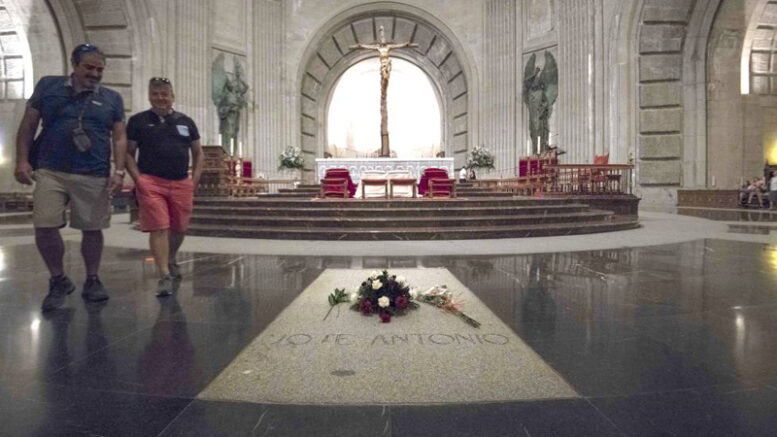Yes, the remains of Spain’s former dictator Francisco Franco have been removed from their place of honour in the Basilica at the Valley of the Fallen monument. But, what’s next for the vast mausoleum complex where nearly 34,000 soldiers and civilian victims of the Spanish Civil War and the subsequent decades of repression under the Franco dictatorship were buried?
According to Spanish news reports, in the immediate future the government of acting President Pedro Sánchez – if he becomes the new president after 10th November general elections – wants to remove the additional tomb of fascist Falange party founder José Antonio Primo de Rivera, which still lies in a place of honour in front of the altar of the Basilica.
Then, the Spanish State’s longtime agreement the Benedictine religious order, which so assiduously protected the Franco legacy at the monument and tried to halt the removal of Franco’s remains last week, would be revoked by the Sánchez government and administration of the Basilica and site would be placed under a new entity.
► News Sources: El Diario, El Pais and CadenaSer …
Longer term, experts and activists within Spain’s “historical memory” movement agree with the government that the Valley of the Fallen should be turned into some form of center for remembering the past of the bloody 1936-39 Spanish Civil War and the 26 years of dictatorship that followed — but, they say, that must be done without glorifying the military uprising that against a democratically elected government or the right-wing ideology that fueled the Franco regime and its systematic violation of human rights for nearly four decades.
That would be in keeping with Spain’s 2007 Historical Memory Law, which says that the Valley of the Fallen should be reconverted into a site that promotes “the aspirations of reconciliation and coexistence that exist in [Spanish] society.” But, how best to do that remains a matter of debate.
Should the site be converted not a learning centre for future generations of Spaniards, focused on an impartial telling of the full story of the civil war and the dictatorship? And, in that case, should the current structures crowned with the largest Christian cross in the whole world be used to house the centre?
Or, as some maintain, should the entire complex be demolished and something new and perhaps more in keeping with the solemnity of the site and the focus on memory of the victims be built in its place?
Or as some believe, should the site be abandoned altogether, to let nature reclaim it and obliterate its position in the national psyche for the last 60 years as a monument to the victorious Franco-led military that rose against and defeated democracy n Spain?
And, in any or all of the above, how does the government deal with the enormous logistical issues of administering or dismantling the largest common grave in Spain, where an estimated 5-10,000 remains of the victims of war and repression buried there are still unidentified and are possibly unidendifiable?
In a televised interview Monday night on Telecinco, Sánchez pledged that if re-elected, his government will proceed by first “speaking with the memorial associations, with the relatives of all those people who have their loved ones buried there”.
“We have to redefine the Valley of the Fallen,” Sánchez told Telecinco news presenter Pedro Piqueras. “We have begun to do so by removing the remains of the dictator and leaving that space only for the victims and I believe that is … not only in the Valley of the Fallen but also in many graves that are pending exhumation” throughout Spain.
► Click to read more about the Historical Memory movement in Spain …
Check out more news from Spain about:
► Animal Welfare ► Corruption/Transparency ► Discrimination ► Education ► Environment & Sustainability ► Fair Trade & Development Aid ► Healthcare ► Historical Memory ► Housing & Homelessness ► Human Rights ► Labour & Unemployment ► LGBT ► Peace & War ► Politics ► Poverty ► Refugees & Migration ► Technology & Social Enterprise ► Women’s Rights

